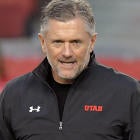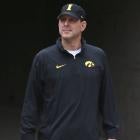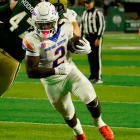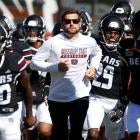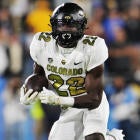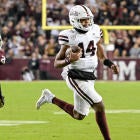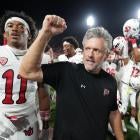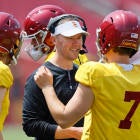Last month, the CBS Sports college football braintrust submitted ballots that were compiled to create our annual ranking of the 65 Power Five coaches. In the case of the Pac-12, that meant stacking many new, incomplete and in-process profiles against their Power Five peers. The final balloting revealed no coaches in the top 10 nationally but three in the top 25 and seven of the league's 12 coaches in the top 41.
While it's undeniable that the Pac-12's absence from the College Football Playoff -- with the least amount of appearances (2) among Power Five conferences and no national title contenders since Marcus Mariota and Oregon in 2014 -- has an impact on other subjective matters like coach rankings, I think there is a simpler point to be made regarding this year's snapshot. The Pac-12 as it stands heading into 2020 is a league with very few coaches entrenched in their current position.
The familiar names atop the list are Kyle Whittingham and David Shaw, and while they have each proven to be among the best in the business, they are also the only coaches remaining from the 2015 Pac-12 Media Day lineup. When the rest of the league is stacked up against these two, and especially against some of the other Power Five coaches with long track records at their current stop, the small sample size is going to hurt their ranking.
There's one big group around the middle of the rankings that will split in the coming years between those moving up and those moving out, and another group of new-ish faces in new places near the bottom. Our voters have consistently taken a wait-and-see approach whenever coaches take over a program. And when 10 of the 12 jobs have changed in the last five years, there is still going to be some waiting left for most of the conference.
Complete Power Five coach rankings: 1-25 | 26-65
| 1 | |
| Kyle Whittingham (11 overall): When Utah made the move to the Pac-12, few expected the league's new addition to be one of the most consistent programs of the two-division era. Since 2014, Utah has won nine or more games five times, finished ranked in the top 25 four times and laid claim to three Pac-12 South division titles. Whittingham's stock has never been higher than the present, coming off an 11-3 season and a second-straight Pac-12 Championship Game appearance. The only way it could improve would be for the Utes to take the next steps by actually winning the conference title and making it to the College Football Playoff. Last year: 4 | |
| 2 | |
| David Shaw (19): While Shaw still holds a high ranking among his Pac-12 peers, his Power Five-wide ranking has taken a hit as Stanford took a step back from what was annual Pac-12 title contention for much for much of the last decade. The Cardinal went 4-8 in 2019, and while that record could be explained away by rampant injury issues, its presence as an outlier on the David Shaw profile -- which previously included no seasons without a bowl appearance and 8-5 as his worst single-season record -- has been noted. The 2019 season was either an anomaly with course correction coming in 2020 or a warning sign that the years of predictable consistency are over on The Farm. Last year: 2 | |
| 3 | |
| Mario Cristobal (24): Of all the former Nick Saban assistants making their way as head coaches right now, few have helped usher in a total culture transformation such as what we've seen from Cristobal's Ducks. It's a program built from the trenches out, with a mentality centered around physicality, which reflects Cristobal's time as the offensive line coach in Tuscaloosa. That, paired with a relentless work ethic on the recruiting trail that helped bring five-star talent like Kayvon Thibodeaux and Justin Flowe to Eugene, has changed the trajectory of the Oregon program. After winning a Pac-12 title and the Rose Bowl, Oregon now sets its sights on becoming just the fifth program with multiple College Football Playoff appearances. Last year: 7 | |
| 4 | |
| Herm Edwards (30): The last few hiring cycles have been notable for what were then identified as non-traditional hires, breaking the expected cycles of coordinators graduating to head coaches and those head coaches moving linearly up and down through a perceived conference hierarchy. But every year that Herm Edwards continues to succeed is more proof that all expectations of coaching hires -- who gets hired, where they come from, college experience and even recent experience -- should be thrown out the window. Coaching is teaching, and the rules of football don't change that much over time. Edwards came in with a vision for recruiting and development at a high level, and its immediate impact is changing our perception of his coaching legacy as much as it is our expectations for coaching hires. Last year: 10 | |
| 5 | |
| Justin Wilcox (33): In one sense, it seems like Wilcox should be higher on this list. We are about to enter Year 4 of Wilcox's head coaching career, and each season has been marked by improvement. The Bears have gone from five wins to seven wins to eight wins and a bowl victory in 2019. But this ranking is against his peers in the Pac-12, where he currently has a 10-17 record in conference play. The 2020 season is all about the next step for Wilcox and the Bears as they hope to contend with Oregon and Washington in the Pac-12 North and, at a minimum, finish with a winning record in conference play for the first time in his tenure. Last year: 8 | |
| 6 | |
| Chip Kelly (36): A 3-9 debut did little to shake our voters' confidence in Chip Kelly after 2018, but just a one-win improvement to 4-8 last year has made the 46-7 run at Oregon seem even further in the past. The most frustrating part of the Chip Kelly era at UCLA has been the disparity between its best performances, including two wins against top-25 opponents in 2019, and its worst, like the 20-17 loss at Arizona or 49-3 defeat at Utah after a bye week. Last year: 3 | |
| 7 | |
| Clay Helton (41): No coach is more interesting from a ranking perspective than Helton. He boasts a Pac-12 championship, a Rose Bowl win and has finished either as the champion or runner-up in the Pac-12 South in four of his five full seasons as the Trojans' head coach. I believe Helton's ranking is heavily influenced by two factors, neither of which he can control: two full seasons of hot seat discussion and the distance between USC's success under Helton and the national championship contention that many expect from this program. He's got hardware, sure, but USC has also lost at least three games in each of his five full seasons, and we know real title contention exists with a razor-thin margin for error. Last year: 9 | |
| 8 | |
| Nick Rolovich (50): There's a lot of credit applied here by our voters for bringing pride and conference title contention back to the Hawaii football program. Rolovich is a high-ceiling coach with a personality that will keep Washington State's media availability interesting, but maintaining the level of success established by two-time Pac-12 Coach of the Year Mike Leach will be a challenge in the ultra-competitive Pac-12 North. Last year: N/A | |
| 9 | |
| Jonathan Smith (52): Any regular listeners of the Cover 3 Podcast know that Jonathan Smith and his Oregon State program are worth your attention. Will Smith have the Beavers competing for the Pac-12 North title in 2020? Probably not. But watching the way this team has rebuilt from the ground up over the last two seasons suggests the days of Oregon State as the conference doormat are over. The Beavers took down both Arizona State and Cal last year and lost three games by three points or less before falling one win short of bowl eligibility in 2019. Last year: 11 | |
| 10 | |
| Kevin Sumlin (53): If you value entire coaching history with consideration for work done at previous stops, then Sumlin was underrated by our voters. This ranking suggests that more emphasis was placed on his 9-15 record in two years with Arizona than his 51-26 record in six years with Texas A&M or his 12-1 breakthrough season with Houston in 2011. Sumlin was a late-cycle hire after Rich Rodriguez was dismissed, and at every step, the timing has just been off. There have been waves of transfers, midseason staff shakeups and, most notably, a disappointing finish to Khalil Tate's college career after an explosive breakout in 2017. Last year: 6 | |
| 11 | |
| Jimmy Lake (56): As we mentioned above, our coach rankings voters have a tendency to lean towards wait-and-see approaches with first-year coaches. Allow me to be the first to predict that Lake will have the biggest one-year jump of all coaches when we circle back to do these rankings again in the 2021 offseason. Lake has been the architect of Washington's defense under Chris Petersen, and that defense has been a main factor in the identity and success of the Huskies program in the College Football Playoff era. Last year: N/A | |
| 12 | |
| Karl Dorrell (64): Mark Dantonio stepped down at Michigan State, Mel Tucker introduced 24 signees from Colorado's 2020 recruiting class and, just one week later, he left to take the Spartans head coaching position. All of it happened in eight days, and the toughest hand dealt was to the Buffs and the players who had just committed to Tucker's vision for Colorado's future. It's been 15 years since Dorrell was named the Pac-12 Coach of the Year at UCLA, but that experience must inform his efforts now to steady a program that's on its third coach in as many years. Last year: N/A | |
























